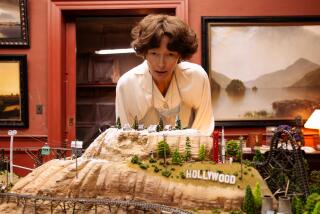Telluride Film Festival: ‘Tim’s Vermeer’ explores art, science
- Share via
TELLURIDE, Colo. -- Tim Jenison makes it very clear in the beginning of the Telluride Film Festival documentary “Tim’s Vermeer” that he is not an artist.
He’s a desktop-video inventor, the founder of a hardware and software company called NewTek.
But Jenison is as fascinated by art as he is by technology, and not that long ago he began to wonder if modern machinery in its more nascent forms might have been employed by painters centuries ago.
PHOTOS: Fall movie sneaks 2013
So he began an experiment that at first seemed both inspired and insane: to use rudimentary devices to paint the 17th century masterpiece “The Music Lesson” by Johannes Vermeer just as he imagined the Dutch artist had.
“At the face of it that seems almost impossible,” Jenison says of his painting plans in “Tim’s Vermeer, “ which is having its world premiere in Telluride. “Because I am not a painter.”
The film, directed by the magician Teller in his feature-film debut, is a fascinating exploration of how Vermeer might have used lenses and mirrors to master the representation of light and perspective. In a larger sense, it challenges the idea that art and science, rather than being divergent fields, can actually be complementary.
WATCH: Trailers from Telluride
Compared with his contemporaries, Vermeer was able to depict the nuanced details of photorealism far better than his painter peers at the time, nearly 200 years before the invention of photography. Some academics and artists — including David Hockney — are convinced Vermeer didn’t just paint by sight. “There is no explanation for the paintings without optics,” the British painter says of Vermeer’s work.
Jenison’s idea is mathematically simple: that by using a fixed, dentist-sized mirror that is both reflecting and obscuring a reflection of an image, he can match on a blank slate the exact colors and boundaries of the reflected image.
Imagine the shaft of light that comes from a slide projector, but in this case the beam is the reflection of an illuminated painting. By slightly shifting his eye from what he is painting to what he sees in his so-called “comparator mirror,” Jenison can look for the point on the edge of the mirror where there is no difference between the original reflection and his new painting, meaning that he has made a perfect copy of the original.
PHOTOS: Telluride Film Festival 2013
Jenison mentioned the idea to the magician Penn Jillette four years ago, who immediately decided that he wanted to follow Jenison with a film crew. Jillette and Farley Ziegler produced the film, with Teller directing.
As proof of concept, Jenison painted a copy of a photograph of his father in law. But over the course of “Tim’s Vermeer,” the inventor decided not only to use the same techniques to replicate a complex canvas but also to reconstruct in a Texas warehouse the 17th century room in which Vermeer placed his models for “The Music Lesson.”
The documentary, which is set to come out early next year from Sony Pictures Classics, is an almost existential personal quest, as Jenison’s painting takes months of long days of work. At one point, he concedes that were it not for Teller’s film crew he would probably ditch the whole effort.
Fortunately, for “Tim’s Vermeer,” he doesn’t.
ALSO:
Trailer for Steve McQueen’s “12 Years a Slave.”
‘Shame’s Michael Fassbender, Steve McQueen on a serious roll
From ‘Gravity’ to “12 Years a Slave,” film fare gets serious this fall
More to Read
Only good movies
Get the Indie Focus newsletter, Mark Olsen's weekly guide to the world of cinema.
You may occasionally receive promotional content from the Los Angeles Times.











